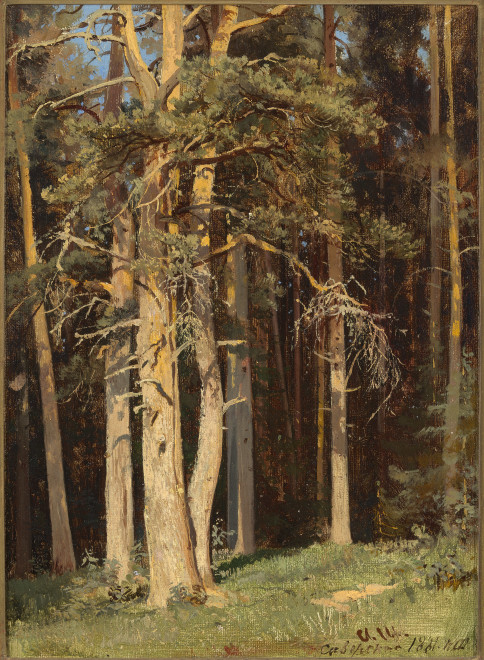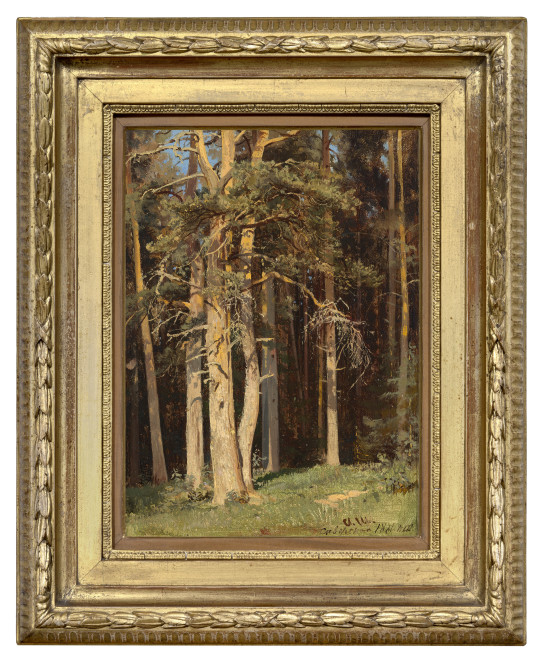“We know no other artist who possesses such impeccable technique or who so faithfully and with such deep affection for his native land and his art portrays the Russian nature that is so dear to us. In the depiction of the Russian forest, Shishkin has no rivals.” (Victoria Charles and Irina Shuvalova, Ivan Shishkin, 2013, Kindle edition, p. 108).
Provenance
Sale, Sotheby’s New York, 24 May 1984, lot 208
Private American collection (acquired at the above sale)
Exhibited
Minneapolis Institute of Art (on loan from 2006 to 2021, not on exhibition)
Catalogue note
Referred to as the “Tsar of the Forest” during his lifetime, Ivan Shishkin (1832-1898) is considered one of Russia’s greatest landscape painters. To quote one of his contemporaries, “We know no other artist who possesses such impeccable technique or who so faithfully and with such deep affection for his native land and his art portrays the Russian nature that is so dear to us. In the depiction of the Russian forest, Shishkin has no rivals.” (Victoria Charles and Irina Shuvalova, Ivan Shishkin, 2013, Kindle edition, p. 108). While the Russian forest provided Shishkin with an endless source of inspiration, equally, his paintings defined Russia by always promoting a sense of pride in the native landscape.
A turning point in Shishkin’s career came in 1870, when together with a group of Russia’s most talented artists, including Ilya Repin (1844-1930), Vasily Surikov (1848-1916), Ivan Kramskoi (1837-1887), Viktor Vasnetsov (1848-1926) and Konstantin Savitsky (1844-1905), he founded the Society for Travelling Exhibitions or Peredvizhniki. While a focus of the group was to feature realistic contemporary life in Russia (best exemplified by Ilya Repin’s Volga Barge Haulers from 1870-73, State Russian Museum, St. Petersburg), there was also a keen interest in depicting the diverse beauty of the Russian countryside, such as exemplified in Shishkin’s landscapes and especially in his pine forests. The ideology of the Peredvizhniki remained with Shishkin for the rest of his career and was a defining characteristic of his landscapes from the 1880s, such as Siverskaya - Edge of the Forest.
Painted in 1881, the setting of our woodland scene is Siverskaya, located 70 kilometers south of St. Petersburg. Shishkin had explored the region with fellow Peredvizhniki, Kramskoi and Savitsky in 1872; with the natural beauty of the terrain and the towering trees of the forest, Shishkin found his muse in Siverskaya, and it provided him with endless natural subjects for the rest of his career. Siverskya was to Shishkin what Ville d’Avray had been to Jean-Baptiste-Camille Corot and Fontainebleau Forest had been to Théodore Rousseau; the shared understanding of a force in nature so strong that it beckoned to be repeated over and over. Shishkin’s woodland subjects have been referred to as “forest portraiture” and it is tempting to assign attributes such as “close up” and “full length” when describing the trees with their sturdy trunks covered with crusted bark, twisting branches and feathery pine needles. Here we see a “close up” view of the forest in light and shadow, a trademark Shishkin vantage point, where the towering pine trees – their trunks softly illuminated in sunshine, extend out of the picture and reach upwards beyond the blue sky.




